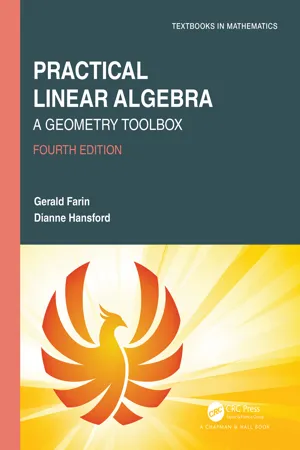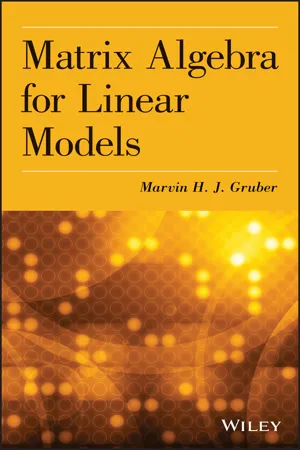Technology & Engineering
Cramer's rule
Cramer's rule is a method used to solve systems of linear equations. It involves using determinants to find the values of the variables in the system. This method is particularly useful when there are only a few variables in the system.
Written by Perlego with AI-assistance
Related key terms
Related key terms
1 of 4
Related key terms
1 of 3
4 Key excerpts on "Cramer's rule"
- eBook - ePub
- Ruriko Yoshida(Author)
- 2021(Publication Date)
- Chapman and Hall/CRC(Publisher)
Therefore we do not have any supplemental python code in this section. 3.5 Cramer's rule If we know a system of n linear equations with n variables has a unique solution, we can apply Cramer's rule to find the unique solution to the system of linear equations. This rule gives an explicit formula for the unique solution using determinants, thus it is very fast to compute. In this section we focus on Cramer's rule and discuss how we can apply it to systems of linear equations. 3.5.1 Task Completion Checklist During the Lecture: Read the definition of Cramer's rule. Learn how to apply Cramer's rule to solve a system of linear equations. Try some examples without the help of a computer. With R, learn how to perform computational examples in this section. Read the definition of the adjugate matrix of an invertible matrix. After the Lecture: Take conceptual quizzes to make sure you understand the materials in this section. Do some regular exercises. Conduct lab exercises with R. Conduct practical applications with R. If you are interested in python, read the supplement in this section and conduct lab exercises and practical applications with python. 3.5.2 Working Examples We go back to the Practical Applications in Section 2.3 to see if the solution using Cramer's rule coincides with the solution using the reduced echelon form. Recall that we worked on the Guinness data set with additional information collected from Guinness Ghana Ltd. on the supply of Malta Guinness from two production sites, Kaasi and Achimota, to nine key distributors geographically scattered in the regions of Ghana. Table 1.3 shows the demands from the distributors and supplies from the production sites. Recall that here we have a system of linear. equations x 11 + x 12 + … + x 19 = 1298 x 21 + x 22 + … + x 29 = 1948 x 11 + x 21 = 465 x 12 + x 22 = 605 x 13 + x 23 = 451 x 14 + x 24 = 338 x 15 + x 25 = 260 x 16 + x 26 = 183 x 17 + x 27 = 282 x 18 + x 28 = 127[--=PLG - eBook - ePub
Practical Linear Algebra
A Geometry Toolbox
- Gerald Farin, Dianne Hansford(Authors)
- 2021(Publication Date)
- Chapman and Hall/CRC(Publisher)
solution space exist.- There is exactly one solution vector u. In this case,| A | ≠ 0, thus the matrix has full rank and is non-singular.
- There is no solution, or in other words, the system is inconsistent. (See Section 5.6 for a geometric description.)
- There are infinitely many solutions. (See Sections 5.7 and 5.8 for examples.)
5.3 A Direct Approach:
Cramer's ruleA method for solving a linear system explicitly using ratios of determinants.Sketch 5.2 offers a direct solution to our linear system. By inspecting the areas of the parallelograms in the sketch, we see thatu 1=,area ( b ,a 2)area (a 1,a 2)u 2=.area (a 1, b )area (a 1,a 2)Sketch 5.2. Cramer's rule.An easy way to see how these ratios of areas correspond to u1 and u2 is to shear the parallelograms formed byb ,anda 2b ,onto the a1 and a2 axes, respectively. (Shears preserve areas; see Section 4.7 .) The area of a parallelogram is given by the determinant of the two vectors spanning it. Recall from Section 4.10 that this is a signed area. This method of solving the linear system is called Cramer's rule.a 1Example 5.2Applying Cramer's rule to the linear system in (5.3), we getu 1==4 44 62 41 68 8,u 2==2 41 42 41 64 8.Examining the determinant in the numerator, notice that b replaces a1 in the solution for u1 and then b replaces a2 in the solution for u2 .If the area spanned by a1 and a2 is zero, that is, the vectors are multiples of each other, then Cramer's rule will not result in a solution. (See Sections 5.6 –5.8 - eBook - ePub
- P.M. Cohn(Author)
- 2017(Publication Date)
- Chapman and Hall/CRC(Publisher)
Hence the solution of (5.18) may be written as the quotient of two determinants: x i = | A (i) | | A | (i = 1, …, n) (5.20) where the matrix A (i) is defined by (5.19). This formula for the solution of a regular system of equations is known as Cramer’s rule (it appeared in Cramer’s work, Introduction à l’analyse des lignes courbes, 1750). It is mainly of theoretical interest, since for a practical solution the Gaussian elimination of Chapter 2 is considerably quicker than evaluating n + 1 determinants of order n. With the help of Cramer’s rule we can give another proof, due to Kronecker, of the multiplication theorem of determinants (Theorem 5.1): | A B | = | A | ⋅ | B | (5.14) This equation may be regarded as an identity in the 2 n 2 entries of A and B. If we regard these entries as variables, the determinants | A |, | B |, | AB | are all non-zero, because they do not vanish identically − for example, they are 1 when A = B = I. Thus we may assume A, B, and AB to be regular in what follows. The system Bx = k has a unique solution, which by Cramer’s rule may be written x i = | B (i) | | B | where B (i) = (b 1, …, b i − 1, k, b i + 1, …, b n) Here b 1, …, b n are the columns of B, so that B (i) does not involve the i th column of B. Now the solution of Bx = k plainly also satisfies the equation A B x = A k whose solution is, again by Cramer’s. rule, x i = | A B (i) | | A B | where A B (i) = A (b 1, …, b i − 1, k, b i + 1, …, b n) = (A b 1, …, A b i − 1, A k, A b i + 1, …, A b n) Since the solution is unique, it is the same in each case,. so | B (i) | | B | = | A B (i) | | A B | i = 1, …, n Here neither numerator vanishes if we regard the components of k as variables, so we obtain | A B | | B | = | A B (i) | | B (i) | i = 1, …, n (5.21) In this equation the right-hand side does not involve the i th column of B, therefore neither does the left-hand side - eBook - ePub
- Marvin H. J. Gruber(Author)
- 2013(Publication Date)
- Wiley(Publisher)
The matrix A is called the coefficient matrix. The matrix [A, b] is called the augmented matrix. For example, the system can be written The system may be writtenThere are some different methods of solving these equations. These include Cramer’s method, Gauss elimination, and the use of the inverse of the matrix A. We will take up Cramer’s rule first in this subsection. The next subsection will take up Gauss elimination, and the use of the inverse of a matrix will be discussed in Section 3.Consider two equations in two unknowns, sayFollowing a procedure that is generally taught in high school, we eliminate the x2 variable by multiplying the first equation by a22 and the second equation by − a12 .We then add the results to obtain so thatSimilarly, the variable x1 could be eliminated, and we would obtainThis is Cramer’s rule for two equations in two unknowns. It is an easy formula to remember because the matrix in the denominator is the coefficients of x1 and x2 in the two equations and the matrix in the numerator is the same with the numbers on the right-hand side of the equation replacing the first column for x1 and the second column for x2 . This idea generalizes to n equations in n unknowns. We now give a more formal derivation of Cramer’s rule.Let C ij = (−1)i + j Aij where Aij is the (n − 1) × (n − 1) submatrix formed by deleting the ith row and the jth column. The Cij are called cofactors. Let adj(A) (the adjoint matrix of A) be the matrix with elements Cji , the transpose of the matrix of cofactors. The elements of the matrix(2.3)Thus,(2.4 )Let Aj represent the n × n matrix with the elements of A everywhere but the jth column. The jth column consists of the n-dimensional column vector b. The determinant of Aj
Index pages curate the most relevant extracts from our library of academic textbooks. They’ve been created using an in-house natural language model (NLM), each adding context and meaning to key research topics.
Explore more topic indexes
Explore more topic indexes
1 of 6
Explore more topic indexes
1 of 4



